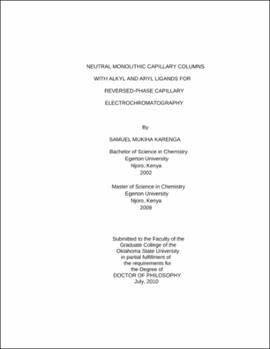| dc.contributor.advisor | El Rassi, Ziad | |
| dc.contributor.author | Karenga, Samuel Mukiha | |
| dc.date.accessioned | 2013-11-26T08:21:26Z | |
| dc.date.available | 2013-11-26T08:21:26Z | |
| dc.date.issued | 2010-07 | |
| dc.identifier.uri | https://hdl.handle.net/11244/6455 | |
| dc.description.abstract | Scope and Method of Study: | |
| dc.description.abstract | The broad objective of this dissertation involved an integrated approach for furthering the advancement of reversed-phase capillary electrochromatography (RP-CEC) by providing an improved design of neutral acrylate/methacrylate-based monoliths offering both hydrophobic and pi interactions for separating a wide range of solutes including polyionic biomolecules such as peptides and proteins. Being neutral, the monoliths were void of fixed charges that are traditionally incorporated to support EOF but still afforded relatively strong electrosomotic flow (EOF) necessary for mass transport in the absence of annoying electrostatic interactions. Such interactions would otherwise lead to irreversible adsorption of charged analytes to the stationary phase surface, causing band broadening and irreproducible retention times. Towards this end, octadecyl acrylate monoliths (ODM), naphthyl methacrylate monoliths (NMM), segmented monolithic columns (SMC) and mixed ligand monoliths (MLM) were developed and evaluated. | |
| dc.description.abstract | Findings and Conclusions: | |
| dc.description.abstract | The investigation described in this dissertation has significantly contributed to enhancing the scope of RP-CEC by demonstrating its capabilities in areas that had not been largely exploited previously. Although without fixed charges, the neutral monoliths afforded relatively strong EOF through the adsorption of ions from the electrolyte, which imparted the monolith with a given zeta potential to generate the EOF necessary for mass transport. The ODM columns provided hydrophobic interactions while the naphthyl methacrylate columns exhibited both hydrophobic and pi interactions. By changing the choice of the crosslinker, the EOF, retention and selectivity of the ODM and NMM were tuned. Similarly, the preparation of SMC and MLM provided a convenient way of tuning the magnitude of EOF, retention and selectivity towards both neutral and charged solutes. The novel stationary phases developed within the framework of this investigation will not only facilitate a solution to many separation problems in life sciences, but also contribute to new concepts that will broaden the utility of RP-CEC in the future. | |
| dc.format | application/pdf | |
| dc.language | en_US | |
| dc.rights | Copyright is held by the author who has granted the Oklahoma State University Library the non-exclusive right to share this material in its institutional repository. Contact Digital Library Services at lib-dls@okstate.edu or 405-744-9161 for the permission policy on the use, reproduction or distribution of this material. | |
| dc.title | Neutral monolithic capillary columns with alkyl and aryl ligands for reversed-phase capillary electrochromatography | |
| dc.contributor.committeeMember | Bunce, Richard A. | |
| dc.contributor.committeeMember | White, Jeffery L. | |
| dc.contributor.committeeMember | Slaughter, LeGrande M. | |
| dc.contributor.committeeMember | Mort, Andrew J. | |
| osu.filename | Karenga_okstate_0664D_11027.pdf | |
| osu.accesstype | Open Access | |
| dc.type.genre | Dissertation | |
| dc.type.material | Text | |
| dc.subject.keywords | capillary electrochromatography | |
| dc.subject.keywords | neutral monoliths | |
| dc.subject.keywords | peptide mapping | |
| dc.subject.keywords | polycyclic aromatic hydrocarbons | |
| dc.subject.keywords | positional | |
| thesis.degree.discipline | Chemistry | |
| thesis.degree.grantor | Oklahoma State University | |
